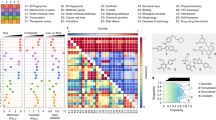Abstract
Targeting protein superfamilies via chemogenomics is based on a similarity clustering of gene sequences and molecular structures of ligands. Both target and ligand clusters are linked by generating binding affinity profiles of chemotypes vs a target panel. The application of this multidimensional similarity paradigm will be described in the context of Lead Generation to identify novel chemical hit classes for G-protein coupled receptors.
Access this chapter
Tax calculation will be finalised at checkout
Purchases are for personal use only
Preview
Unable to display preview. Download preview PDF.
Similar content being viewed by others
References
Beroza P, Villar HO, Wick MM, Martin GR (2002) Chemoproteomics as a basis for post-genomic drug discovery. Drug Discov Today 7:807–814
Bleicher KH (2002) Chemogenomics: bridging a drug discovery gap. Curr Med Chem 9:2077–2084
Bredel M, Jacoby E (2004) Chemogenomics: an emerging strategy for rapid target and drug discovery. Nat Rev Genet 5:262–275
Caron PR, Mullican MD, Mashal RD, Wilson KP, Su MS, Murcko MA (2001) Chemogenomic approaches to drug discovery. Curr Opin Chem Biol 5:464–470
Cerep (2005) http://www.cerep.fr/Cerep/Users/index.asp
Crossley R (2004) The design of screening libraries targeted at G-protein coupled receptors. Curr TopMed Chem 4:581–588
Daylight Chemical Information Systems, Inc., http://www.daylight.com (2002)
Dixon SL, Villar HO (1998) Bioactive diversity and screening library selection via affinity fingerprinting. J Chem Inf Comput Sci 38:1192–1203
Fliri AF, Loging WT, Thadeio PF, Volkmann RA (2005) Biological spectra analysis: linking biological activity profiles to molecular structure. Proc Natl Acad Sci U S A 102:261–266
Frye SV (1999) Structure-activity relationship homology (SARAH): a conceptual framework for drug discovery in the genomic era. Chem Biol 6:R3–R7
Guba W, Neidhart W, Nettekoven M (2005) Novel and potent NPY5 receptor antagonists derived from virtual screening and iterative parallel chemistry design. Bioorg Med Chem Lett 15:1599–1603
Jacoby E (2001) Quant Struc-Act Relat 20:115–123
Jacoby E, Fauchere J-L, Raimbaud E, Ollivier S, Michel A, Spedding M (1999) A three binding site hypothesis for the interaction of ligands with monoamine G protein-coupled receptors: implications for combinatorial ligand design. Quant Struct-Act Relat 18:561–571
Jacoby E, Schuffenhauer A, Floersheim P (2003) Chemogenomics knowledge-based strategies in drug discovery. Drug News Perspect 16:93–102
Kauvar LM, Higgins DL, Villar HO, Sportsman JR, Engqvist-Goldstein A, Bukar R, Bauer KE, Dilley H, Rocke DM (1995) Predicting ligand binding to proteins by affinity fingerprinting. Chem Biol 2:107–118
Krejsa CM, Horvath D, Rogalski SL, Penzotti JE, Mao B, Barbosa F, Migeon JC (2003) Predicting ADME properties and side effects: the BioPrint approach. Curr Opin Drug Discov Devel 6:470–480
Kubinyi H, Müller G (2004) (eds) Chemogenomics in drug discovery. Wiley-VCH, Weinheim
Maggiora GM, Johnson MA (1990) (eds) Concepts and applications of molecular similarity. Wiley-Interscience, New York
Martin YC, Kofron JL, Traphagen LM (2002) Do structurally similar molecules have similar biological activity? J Med Chem 45:4350–4358
Müller G (2003) Medicinal chemistry of target family-directed masterkeys. Drug Discov Today 8:681–691
Palczewski K, Kumasaka T, Hori T, Behnke CA, Motoshima H, Fox BA, Trong IL, Teller DC, Okada T, Stenkamp RE, Yamamoto M, Miyano M (2000) Crystal structure of rhodopsin: a G protein-coupled receptor. Science 289:739–745
Patterson DE, Cramer RD, Ferguson AM, Clark RD, Weinberger LE (1996) Neighborhood behavior: a useful concept for validation of “molecular diversity” descriptors. J Med Chem 39:3049–3059
Porter R, Alanine A (2005) Screening 1:21–23
Savchuk NP, Balakin KV, Tkachenko SE (2004) Exploring the chemogenomic knowledge space with annotated chemical libraries. Curr Opin Chem Biol 8:412–417
Schuffenhauer A, Zimmermann J, Stoop R, Van der Vyver J-J, Lecchini S, Jacoby E (2002) An ontology for pharmaceutical ligands and its application for in silico screening and library design. J Chem Inf Comput Sci 42:947–955
Vertex Pharmaceuticals Incorporated. http://www.vpharm.com
Weinstein JN, Myers TG, O’Connor PM, Friend SH, Fornace AJ Jr, Kohn KW, Fojo T, Bates SE, Rubinstein LV, Anderson NL, Buolamwini JK, van Osdol WW, Monks AP, Scudiero DA, Sausville EA, Zaharevitz DW, Bunow B, Viswanadhan VN, Johnson GS, Wittes RE, Paull KD (1997) An information-intensive approach to the molecular pharmacology of cancer. Science 275:343–349
Wise A, Gearing K, Rees S (2002) Target validation of G-protein coupled receptors. Drug Discov Today 7:235–246
Author information
Authors and Affiliations
Editor information
Editors and Affiliations
Rights and permissions
Copyright information
© 2006 Springer-Verlag Berlin Heidelberg
About this paper
Cite this paper
Guba, W. (2006). Chemogenomics Strategies for G-Protein Coupled Receptor Hit Finding. In: Jaroch, S., Weinmann, H. (eds) Chemical Genomics. Ernst Schering Research Foundation Workshop, vol 58. Springer, Berlin, Heidelberg. https://doi.org/10.1007/978-3-540-37635-4_2
Download citation
DOI: https://doi.org/10.1007/978-3-540-37635-4_2
Publisher Name: Springer, Berlin, Heidelberg
Print ISBN: 978-3-540-27865-8
Online ISBN: 978-3-540-37635-4
eBook Packages: Chemistry and Materials ScienceChemistry and Material Science (R0)




